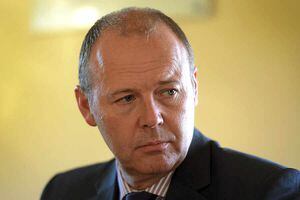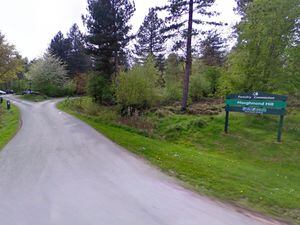Shropshire NHS blueprint will work, insists boss
Shropshire NHS boss Simon Wright today defended his blueprint for the future of services in the county.

He spoke after both
.
The councils said the report was too vague, lacking the detail needed to provide patients with the information they need.
The draft sustainability and transformation plan, or STP, talks of the county having one A&E – but falls short of saying where it should be based. It speaks of the desire to save millions of pounds but doesn't explain how it will be achieved and says services should be moved out of hospitals and into "community hubs" but provides no more information.
Mr Wright, chief executive of Shrewsbury and Telford Hospitals NHS Trust and the lead for the STP, today defended the plans. And he revealed more information could be forthcoming on the future of A&E services following another meeting of NHS bosses tomorrow.
He said: "I think the anxiety both councils have expressed is not surprising. The STP process and the document is a live document which is not going to stay rigid.
"It is something that will continue to evolve as the months and years go by.
"Therefore they have not had the opportunity yet, because it was not finalised until now, to be able to take it through their structure which is different to the commissioners and acute providers.
"We have to acknowledge it is more difficult for our councils because of the way their governance works. I think some of their anxiety is based on that.
"They are active members of the team. They are heavily involved. We have to work together."
Mr Wright said the STP will benefit from public input.
He added: "We are seeking to really look at changing the way our health, social care and voluntary sector work together. I do not think that is vague. I think it is hugely ambitious.
"We are talking about reducing the amount of money we spend in our hospitals in order to support primary and secondary care properly and I think that is a hugely ambitious change.
"We are trying to do this by working through one agenda and this is the first time we have done this."
"I think the reason it is not very precise is because when you are trying to address something if you come up with an answer and then ask everyone what they think you are not going to engage with them.
"We know at a high level what we have to do and we are testing that with specific piloting schemes and projects.
"After that there will be that level of detail that people want to see. It does exist but at this stage we need to test it to see if it works.
"This is a great place and this work is designed to improve the outcomes for the population.
"I really hope people will engage in it. There is lots of place for celebration as we move through the work. A lot of positive steps we hope to take to improve the health of the population."
Proposals part of £22 billion efficiency savings
Ministers claim they will improve healthcare across the country but with their work shielded from the public and shrouded in secrecy, "sustainability and transformation plans" have been a ready target for critics.
The Government–requested plans, which are being drawn up in 44 regions across the country, cover all aspects of NHS spending, from emergency hospitals to community mental health services.
Speculation on their content and purpose has been rife over recent months, a situation exacerbated by NHS leaders ordering that no public comment is made on the plans.
The proposals are being drawn up as part of Government aims to find around £22 billion of efficiency savings in the NHS over the next five years.
In Shropshire, the STP is separate to the Future Fit review of hospitals but does include the controversial revamp of A&E services as part of its overall proposal for the future of the county's healthcare.
The plan is intended to set out a proposal for the entirety of healthcare in Shropshire, although the latest draft report has already been criticised by some of the organisations involved.
Some STPs have contained extensive detail, such as the document published in Leicester & Rutland, which outlines plans to cut the number of acute hospital beds from 1,940 to 1,697, and the movement of hospital services to the Leicester Royal Infirmary and Glenfield Hospital sites.
Its plan has also announced the closure of Hinckley and District Hospital.
Shropshire's STP does include proposals but does not reveal details.
It mentions the proposal to close one of the county's A&Es and create one emergency centre but fails to add any further information about the plans.
It also states that 35,000 outpatient appointments a year could be dealt with outside of hospitals but does not say where.
Earlier this month, Shropshire Council launched a defence of the STP process, but claimed the secrecy was leading "hearsay" in the national media.
Lee Chapman, the council's cabinet member responsible for adults, said: "There is no denying that health and social care services can be delivered more effectively and efficiently if we work together.
"The STP gives extra impetus to deliver improved services for residents whilst saving money.
"We are ahead of the game in Shropshire, we have already made great progress in delivering more joined up work through our health and well-being boards and the STP will progress this further."
However, despite the council's support for the STP process, rifts have opened up with yesterday's publication of the draft Shropshire document.
Both Shropshire Council and Telford & Wrekin Council have openly warned they would not be able to endorse the current plan due to a "lack of confidence in the financial projections and the reliability of the rationale for future cost reductions".
Councillor Malcolm Pate, Leader of Shropshire Council, said: "NHS England have instigated a 'launch' of the STP, which suggests the plans have been fully worked through and agreed by all parties. Unfortunately, this is not the case, as it is the opinion of both Shropshire Council and Telford & Wrekin Council that some elements of the document need developing."
It leaves the future uncertain – and the prospect of months, if not years, of talking before patients will find out what kind of NHS they can look forward to in Shropshire.





